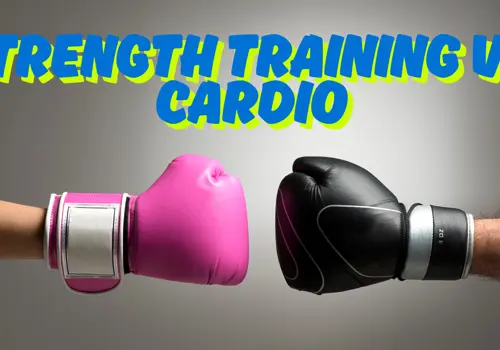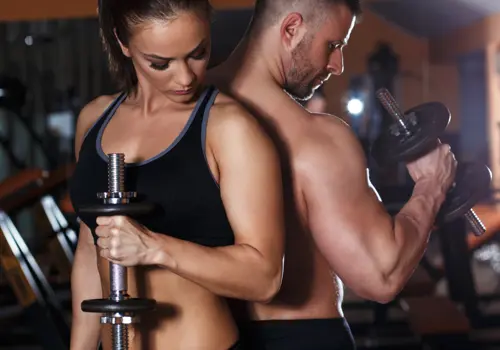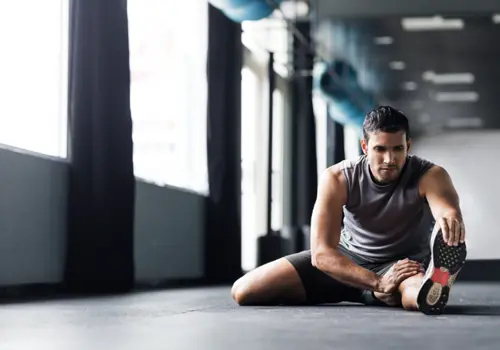Exercises/Workouts • Feb 20, 2025
Top Low-Impact Workouts for Seniors to Protect Joints & Boost Fitness
Top 5 Low-Impact Workouts for Seniors to Protect Joints and Boost Fitness
We can’t help you stay forever young, but we can help you feel your absolute best. That’s a promise.
Staying active as we age is one of the best ways to maintain strength, flexibility, and overall well-being. However, many traditional workouts, like running or high-impact aerobics, can put unnecessary strain on aging joints, making exercise feel more like a chore than a benefit.
Fortunately, low-impact workouts provide a safe and effective way for seniors to stay fit, improve mobility, and protect their joints, all while reducing the risk of injury.
Sound good?
What are low-impact exercises?
Let’s start with the basics. Low-impact exercises focus on smooth, controlled movements that minimize stress on the body while still delivering all the benefits of physical activity. At Svetness, our Senior Fitness Programs offer tailored, often low-impact workout plans to help seniors stay active safely and effectively.
Whether you want to improve cardiovascular health, increase strength, or simply stay active without discomfort, there are plenty of options to choose from. By incorporating these exercises into your routine, you can enhance balance, maintain independence, and boost overall health without the worry of joint pain or excessive strain. Let’s take a closer look at the advantages of low-impact fitness and how it can transform your daily life.
The Benefits of Low-Impact Exercise for Seniors
Engaging in low-impact exercise is one of the best ways for seniors to stay physically active without putting too much stress on their bodies. As we age, joints naturally lose some of their cushioning, and bone density may decrease, making high-impact movements riskier.
However, that doesn’t mean physical activity should be avoided altogether. In fact, regular movement is one of the most effective ways to preserve mobility, maintain muscle strength, and enhance overall quality of life.
Protection For Your Joints
According to our personal trainers, one of the biggest advantages of low-impact workouts is that they help protect joints, ligaments, and bones. These exercises work as part of the best at-home workouts, and allow seniors to stay active without aggravating existing conditions like arthritis or osteoporosis. Instead of causing strain, low-impact workouts support healthy movement patterns, ensuring that the body remains strong and flexible while reducing the risk of falls or injuries.
Cardio Workouts
Beyond joint protection, these exercises also have significant benefits for cardiovascular health, endurance, and energy levels. Engaging in consistent low-impact movement, such as walking or swimming, keeps the heart strong and promotes better circulation.
And better circulation? That can lower blood pressure, improve lung function, and reduce the risk of heart disease.
Boosts Your Mental Well-Being
Anything that can help mental health is a win in our book.
Exercise boosts mood, reduces stress, and combats symptoms of anxiety or depression. Gentle movements such as yoga or water aerobics encourage mindfulness and relaxation, allowing seniors to feel more connected to their bodies while promoting a sense of calm.
Improved Mobility
Maintaining balance and flexibility is also essential for seniors, as it directly impacts mobility and independence.
Low-impact workouts incorporate movements that enhance coordination, strengthen stabilizing muscles, and improve posture, which reduces the likelihood of falls or accidents.
Since falls are one of the leading causes of injury among older adults, exercises that focus on balance and mobility are super important. They provide a proactive way to increase stability and confidence in movement.
What Are the Top 5 Low-Impact Workouts for Seniors?
We know that finding the right exercise is key to maintaining mobility, strength, and overall well-being while keeping joint health a priority. Low-impact workouts help seniors stay active without unnecessary strain, ensuring that movement remains both safe and effective.
Here are five of the best low-impact workouts for seniors, each offering unique benefits for different fitness levels.
Walking: The Ultimate Low-Impact Exercise
Why Walking is Beneficial For Seniors
It sounds simple, but walking is one of the simplest and most effective exercises for seniors. It strengthens the heart, improves circulation, enhances leg strength, and supports joint mobility, all while being gentle on the body.
How to Add Walking to Your Senior Workout
Seniors (and everyone, really!) should focus on maintaining an upright posture, engaging their core, and taking steady, controlled steps.
We always recommend supportive, cushioned footwear that can reduce joint strain. Wherever possible, walking on softer surfaces like grass, rubber tracks, or treadmills can further ease impact. During our at-home personal training sessions, we’ll find the best terrain and surfaces for you.
How to Step Up Your Walking Workout
Adding interval walking (alternating between a normal and brisk pace) helps improve endurance. We also often use light hand weights to engage the upper body. Walking poles offer extra balance support for those who need it.
Walking is Best For: Seniors who want a simple, accessible, and joint-friendly way to stay active.
Swimming & Water Aerobics: Joint-Friendly Full-Body Fitness
Why Swimming is Beneficial For Seniors
The natural workout aid, water provides natural resistance while reducing stress on the joints, making it ideal for seniors with arthritis, osteoporosis, or chronic pain. It’s a fantastic aerobic workout that our trainers love to recommend.
Swimming helps improve muscle tone, cardiovascular endurance, and flexibility without high-impact movements.
How to Add Swimming to Your Senior Workout
Adding in a lap or two if you have access to a pool (either in your apartment complex, home, or at the local center) can change the game.
Warm water can relax muscles and soothe joint pain, making exercises like water walking, gentle leg lifts, arm circles, and aqua jogging particularly beneficial. Holding onto the pool's edge or using a flotation belt offers added stability for those new to water workouts or extra cautious around water.
How to Make a Splash and Enhance Your Swim
Need something a bit more exciting than laps up and down? Seniors can join water aerobics classes, which provide structured, instructor-led sessions that focus on balance, strength, and endurance. Adding foam dumbbells or kickboards can increase resistance and make workouts more challenging.
Our trainers can also suggest complementary workouts to help boost your swim technique and help you feel like a regular Olympian.
Swimming is Best For: Seniors looking for a low-resistance, pain-free way to build strength and endurance.
Chair Exercises: Safe Strength & Mobility Training
Why Chair Exercise is Beneficial For Seniors
Sitting down doesn’t have to be the lazy option! Chair exercises allow seniors to strengthen muscles and improve flexibility while staying seated, making them ideal for those with limited mobility or balance concerns.
How to Add Chair Exercises to Your Senior Workout
Start with the equipment. Using a sturdy chair without wheels is essential for stability!
Exercises like seated marches, toe taps, chair squats, and seated arm raises help strengthen different muscle groups while reducing fall risk and helping create a comfortable workout environment for you to push yourself.
Take a Seat and Boost Your Workout
Adding resistance bands can increase intensity without causing too much strain. Your trainer will help make sure that slow, controlled movements are prioritized over speed to maintain proper form and muscle activation.
Chair Exercises are Best For: Seniors who need a low-risk way to build strength, flexibility, and endurance while seated.
Yoga & Stretching: Improving Balance, Flexibility & Relaxation
Why Yoga is Beneficial For Seniors
It’s a classic for a reason!
Yoga and stretching exercises promote better balance, flexibility, and stress relief while improving posture and joint mobility. Many poses also strengthen stabilizing muscles, reducing the risk of falls.
How to Add Yoga Exercises to Your Senior Workout
There are lots of gentle poses (such as seated cat-cow stretches, standing leg lifts, and supported tree pose) that help maintain flexibility while preventing stiffness. If you need some help nailing the poses or with balance, try using a chair, yoga blocks, or straps to provide extra stability.
Stretch Yourself and Enhance Your Yoga Workout
Seniors who struggle with flexibility can start with gentle seated stretches before moving up to standing poses.
Breathing exercises and mindfulness techniques can also be incorporated to boost mental relaxation, which will also ultimately help your overall performance.
Yoga is Best For: Seniors who want to increase flexibility, reduce stiffness, and improve overall well-being.
Resistance Training: Strength Without Strain
Why Resistance Training is Beneficial For Seniors
Resistance training helps maintain muscle mass, support bone density, and prevent falls—all critical for healthy aging.
Unlike high-impact high-effort workouts, light weightlifting or resistance band exercises provide strength-building benefits without excessive strain.
How to Add Resistance Training to Your Senior Workout
Our personal trainers will help design a bespoke plan that works just for your physique, goals, energy levels, and workout routine.
In general, seniors should start resistance workouts with light dumbbells (2–5 lbs), resistance bands, or bodyweight exercises like wall push-ups and chair squats. As always, make sure to focus on controlled movements with proper breathing to prevent strain or injury.
Feel the Burn: How to Enhance Your Workout
Gradually increasing weight or resistance over time helps ensure progress without overexertion. Incorporating functional exercises, like practicing sitting and standing from a chair, improves daily mobility and independence.
Resistance Training is Best For: Seniors who want to increase strength and stability while protecting joints.
These five low-impact exercises provide seniors with safe and effective ways to stay active, mobile, and strong while protecting their joints.
Whether focusing on walking, swimming, seated exercises, yoga, or resistance training, these workouts can be modified for any fitness level, ensuring long-term health and independence.
Want expert guidance? Svetness Senior Fitness Trainers offer personalized workout plans designed specifically for seniors.
Frequently Asked Questions
Are low-impact workouts effective for building strength?
Yes, absolutely! Low-impact workouts can be just as effective as high-intensity training when it comes to building strength and endurance.
What exercises are recommended for seniors?
Exercises like resistance band training, bodyweight movements, and water aerobics engage muscles without putting stress on joints. Strength-building doesn’t always require heavy weights—controlled, repetitive movements with proper resistance help maintain and even improve muscle mass over time. The key is progressive overload, which means gradually increasing the difficulty of exercises by adding more repetitions, using resistance bands, or incorporating light dumbbells.
How often should seniors exercise?
Seniors should aim for at least 150 minutes of moderate-intensity exercise per week, which breaks down to about 30 minutes a day, five days a week.
Include a combination of walking, swimming, yoga, or strength training. It’s also important to incorporate balance and flexibility exercises at least two to three times per week to help reduce fall risk and improve mobility. The most important thing is to listen to your body and find a routine that feels good and is sustainable.
What if I have arthritis or joint pain? Can I still exercise?
Yes, and in fact, exercise can help relieve arthritis symptoms when done correctly! Consult our Senior Fitness Trainers for a personalized plan.
Low-impact movements like swimming, chair exercises, and yoga are gentle on the joints while still promoting flexibility, circulation, and strength. Water aerobics is great because the buoyancy of water reduces pressure on joints, allowing for pain-free movement.
Stretching and mobility exercises can also ease stiffness and improve joint function over time. If arthritis is a concern, it’s best to start with slow, controlled movements and work with a personal trainer who can create a customized plan to accommodate any discomfort.
Can I do strength training if I have osteoporosis?
In lots of cases yes, and you should! Strength training is actually one of the best ways to combat osteoporosis, as it helps increase bone density, improve balance, and reduce the risk of fractures. Make sure to check with your doctor or medical professional first.
Weight-bearing exercises like bodyweight squats, wall push-ups, and resistance band workouts help keep bones strong. The key is to start light and focus on controlled movements to avoid unnecessary strain. If you have concerns, working with a qualified fitness professional can help ensure you’re performing the right exercises safely.
What should I do if I have trouble balancing during workouts?
If balance is a challenge, there are still many ways to exercise safely. Using a chair for support during standing exercises can help you maintain stability while still engaging your muscles. The most important thing is to progress at your own pace and focus on exercises that build leg strength, core stability, and coordination to enhance balance naturally.




